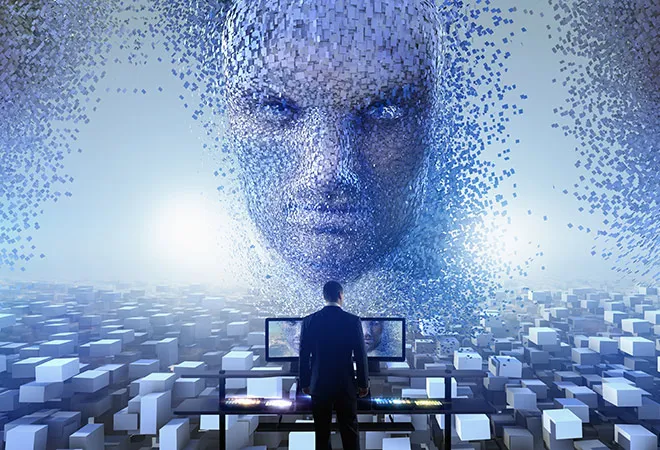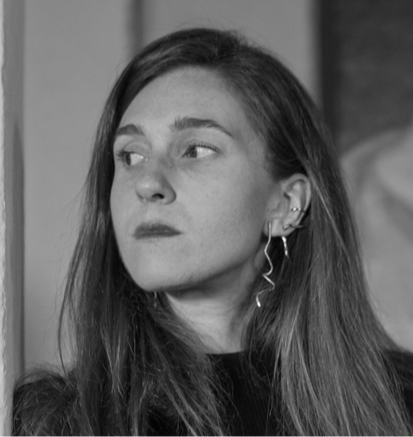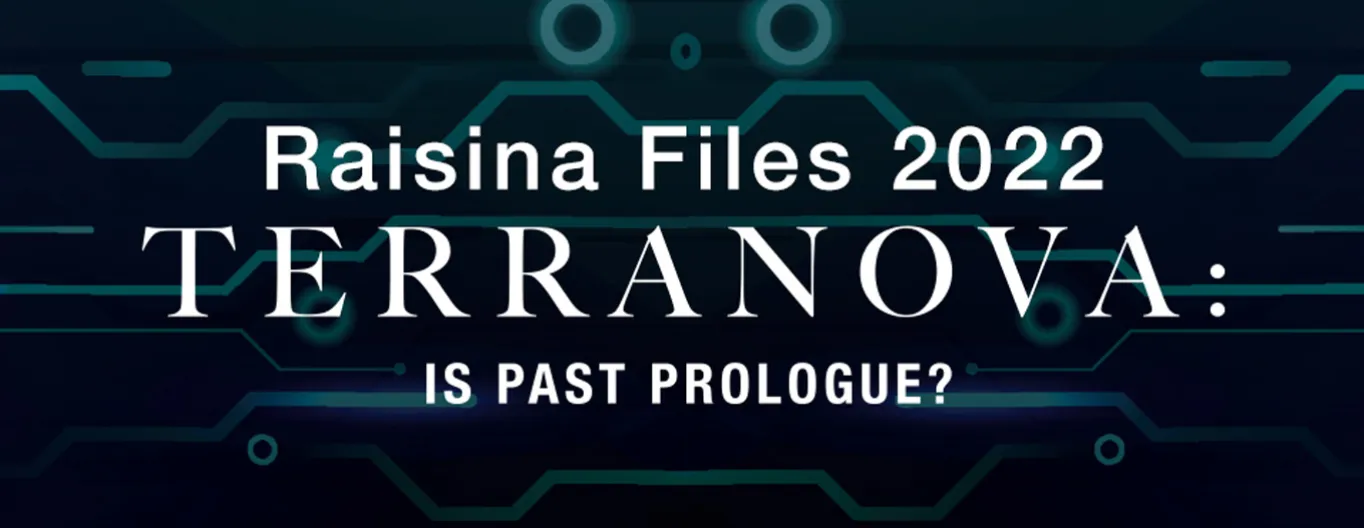
This article is part of the series — Raisina Files 2022.
How Art Corrupts Money
Ten thousand paintings—seemingly identical—mimic one another with same-sized polka dots and can only be differentiated by a watermark in an imbedded hologram. Like banknotes, the canvases are difficult to counterfeit. The same analogy goes for NFTs (non-fungible tokens). On 14 July 2021, an NFT was created for each art piece from Damien Hirst’s remarkable undertaking,
The Currency Project. One year from the auction’s closing, each buyer will have to decide whether to take possession of the real, physical masterpiece (i.e., the
tenner) or its corresponding NFT. Depending on the buyer’s choice, the other option will be permanently destroyed. On 27 July 2022, the auction will come to a close. The dawn of NFTs, and more generally, the metaverse, will make its mark on the art world, offering a dashboard to the constant evolution of digitisation. The shift had been underway since 23 August 2021, when the project first generated US $25 million—a figure made public by the artist on his Instagram profile. Outlining the silhouette of his famous
Shark in Formaldehyde on a sales chart, Hirst commented, “Just when you thought it was safe to go back in the water”.
<1> Simply put, the metaverse represents a vast ocean of opportunities for the art world, which, like the Hirst’s shark, “seems alive when it is dead and dead when it is alive”.
<2> Living in a post-pandemic era, the idea of an alternate universe offers unexplored avenues to expose, profit, and transform the cultural sphere. In the “age of <...> digital reproduction” and virtual reality
, NFTs offer a unique and authentic opportunity to own a piece of art via smart contracts and blockchain technology.
<3> Within this context, cultural- and art-focused NFTs could serve as complementary currency. Joe Hage, the founder of the Heni Group and publisher of Hirst’s masterpieces, stated that, “it is often said that money corrupts art, but this is an attempt by art to corrupt money”
<4>—an opinion or perspective that surpasses
The Currency Project to potentially influence any crosspollination between artistic expression, culture, and the metaverse.
Culture as a Currency: The Next Reality?
Culture is one of the most relevant, intangible forms of power—and so it has been for centuries. Soft power—worth pointing out—is a nation’s ability to exert a certain level of influence to shape preferences by influential leverage. It is the ability to “make others change their behaviour in a desired direction as a result of persuasion” via invisible currency.
<5> As a conceptually attractive and, consequently, influential medium, culture maintains a critical role in understanding contemporary reality. The prominent ArtRewiew rankings proved that out of the 100 most influential people in the art realm, an individual failed to take the number one seat. Instead, for the first time in history, the algorithm ERC-721, a standard for NFTs in Ethereum, won the grand title. This is a clear demonstration of how culture, flourishing in the metaverse, wields intangible influence in the real world as it does in the other dimension. For the foreseeable future, global citizens and their nations will also come face-to-face with this fork in the road of binary realism. Within this pretext, governments will need to invest in soft power to go beyond their image in the physical world, and project their brand and values into the metaverse.
Well before the rise of virtual dimensions, countries were continuously evolving their foreign policies and interactions with the outside world. However, this emergent and increasingly relevant reality is confronting global leaders to participate in an alternate dimension. According to DappRadar’s analytical report, the NFT market reached US $10.67 billion in 2021—a 704 percent increase between Q2 and Q3.
<6> When the year ended, the industry rose to an impressive US $23 billion.
<7> Equally remarkable is the growth rate despite a 2022 cryptocurrency crash in January. Grasping the potential of a new dominion for action, expression, and profit, matched with market traction, governments need to proactively extend the current soft power strategies into the metaverse. This would be achieved by using culture as an intangible currency capable of creating measurable value in both universes.
Meta-soft Power, Beyond the Real World’s Borders
To date, the political expansion of soft power is often implemented through geographical dissemination of important museums, such as the Louvre in Abu Dhabi or Pompidou in Shanghai. With the rise of the metaverse—devoid of territorial and physical boundaries—museums could, in theory, be accessible to everyone. Over the last two years of the pandemic, the creation of corresponding virtual spaces has become an essential component to addressing museum and art gallery closures. Like physical spaces, 3D experiences are used to showcase art and cultural heritage to global audiences, eventually persuading and influencing the real world. It seems no coincidence that Meta's first commercial, published by Zuckerberg on his account, was set in a museum, with four students experiencing an immersive reality in front of an artwork by Henri Rosseau. By seizing both artistic and economic opportunities, some of the major—and mostly state-owned—museums around the world have embraced this new virtual market. Russia’s Hermitage is the first art gallery to enter the metaverse by displaying an exhibition of NFT digital artworks,
There Ethereal Aether, in a virtual reconstruction of its physical venue.
<8> The British Museum created an NFT marketplace and auctioned 200 masterpieces from its unique collections. Other prominent examples include the tokenisation of 200 drawings by the Japanese artist Hokusai
<9> (in collaboration with the LaCollection.io platform) and the recent limited edition of Klimt’s
The Kiss, which was sectioned into 10,000 digital tiles
<10>—each a reproduction of the original painting—launched by the Belvedere Museum in Vienna on Valentine’s Day. Museums have improved their knowledge and development strategies not only in economic terms, but also from an artistic standpoint, by demonstrating the potential of the metaverse’s authenticity and uniqueness.
Museums worldwide are progressively showing the public a new form of art by bridging the past and the present. The bewilderment once caused by modern and contemporary forms of art, such as Impressionism or the Expressionist avant-garde “Die Brücke,” is now generated by Cryptoart—a combination of art, technology and money—which manifests its proprietary qualities simply through its name. However, the most striking example of Cryptoart's success is linked to the auction house Christie's, which sold the digital work
Everydays: The First 5000 Days by Beeple (Mike Winkelmann) for US $69 million,
<11> and
The Merge by Pak for US $91.8 million.
<12>
Creative Industries: A New Conquest
As in our physical universe, soft power can also be virtually applied through recognisable symbols. The
Arco della Pace in Milan was the first monument to venture into the virtual space in collaboration with the Italian start-up Reasoned Art.
<13> They initially created an architectural data sculpture and then transformed the piece into an NFT. The proceeds went towards financing the construction of an educational arena dedicated to digital art and technology. This single metaverse-oriented initiative consolidated the existing influence of soft power and, at the same time, generated a deeper fascination towards Italy – a strategy that can be replicated anywhere. Regardless of the type of monument, architecture and the metaverse are gradually showing their mutual dependence. To confirm this, the 2021 Art Basel Miami Beach presented a virtual gallery “NFTism”
<14> designed by Zaha Hadid Architects to demonstrate the coupling of spatial and interactive experiences.
Music Enters a New Virtual Reality
The COVID-19 pandemic exposed the painful fault lines across the music industry. Amidst the challenges, artists and record labels spotted emergent opportunities to profit and boost visibility in the virtual world. Warner Music Group inaugurated a musical theme park in The Sandbox,
<15> a virtual world, to host events and concerts potentially visible from all over the world, and launched a project in China with virtual DJs and musicians converted into NFTs.
<16> Universal Music also closed a deal with the avatar technology company Genies to bring celebrities, such as Billie Eilish and Taylor Swift, into the metaverse.
<17> Artists like Justin Bieber have already performed with real-time motion capture in this new dimension, just as ABBA recently confirmed their upcoming virtual tours.
<18> Within this context, the considerations of Cryptoart may also apply to music: When it comes to soft power, the advantages include the potential sale of NFTs and heightened prominence on a global stage via a low-cost platform. This is especially beneficial for those artists—and their country of origin—who lack presence and visibility. The premise lies in institutionalising an existing but hidden heritage within a new dimension.
The Metaverse Disrupts the Future of Cinema
For decades, the global film culture enjoyed soft power in attracting foreign and domestic travellers through screen tourism.
<19> Immersive cinema seems to achieve the utopia of the Twentieth-Century avant-garde movements, which crave more immersive and synesthetic artworks. When an audience actively engages in a new narrative using VR headsets, it presents an opportunity to refill the now-empty seats in movie theatres. However, a parallel world, where our avatars go to the cinema, has likewise emerged: The case of Christopher Nolan's
Tenent screening on Fortnite in June 2020
<20> is the forerunner of this trend, representing an untapped potential for the film and TV sector. In relation to media streaming, now inseparable from cinema, the future remains unpredictable. Yet, a group of DAO’s investors—who operate on blockchains—plans to buy the Blockbuster brand from Dish Network to relaunch the platform as an on-demand virtual streaming service.
<21>
Literature Works Go 3D
Finally, it is worthwhile to consider the role of literature, whose texts have fed people’s collective imagination and willingness to travel to faraway countries. Today, the intersection with the metaverse is still rare, but herein lies several interesting findings. Alessandro Baricco is the first author to turn literary masterpieces – his novel
Novecento – into an NFT, which sold at a higher bid compared to the printed version (today at US $179.73 on OpenSea).
<22> Miyuki Ono published
Pure’s NFT to make the text available in several languages – unusual for Japanese literary works – and, therefore, reach global audiences.
<23> These examples could encourage other authors to approach blockchain technology, particularly to avoid editorial brokerage fees. For instance, the self-publishing platform NFTBooks,
<24> which also operates as a low-cost digital bookstore, is now moving in this direction.
Decentralisation, Emerging Economies and Emerging Risks
By leveraging digital in both creation and sales processes, artists obtain rewarding benefits from the metaverse in terms of attribution and distribution. Firstly, thanks to NFTs, this alternate exhibit space overcomes the problem of ownership and disposal of previously unsaleable works: unlike before, now it is possible to certify properties in the virtual world. Cryptoart creatives can also showcase their works to a wider international audience, earning royalties on sales. This “copyright” secured by smart contracts are particularly relevant for American artists, who are not protected under specific federal law. Despite the progressive entry of auction houses into the metaverse (e.g., Sotheby's metaverse) and the presence of marketplace giants (e.g., SuperRare, OpenSea, Nifty, Rarible), Cryptoart remains a broker-free space. The decentralisation of art, beyond conventional art galleries and auction houses, has enabled even less well-known creators to reach high valuations. These authors perform independently, often only supported by marketplace platforms that assist amateur artists to mint their NFTs (e.g., Artsted).
Why should governments participate in this modern artform? How can such investments increase their soft power? To answer these questions, it is worthwhile to highlight relevant data compiled by the Finder Editorial Review Board. To date, the Philippines observe the highest number of NFT owners (32%) compared to 20 other nations, followed by Thailand (27%), Malaysia (24%), UAE (23%), and Vietnam (17%). In contrast, Japan has the lowest percentage of the sample (2%), behind the UK and US (3%), Germany (4%), Australia (5%), and Canada (6%). As the NFT 2021 report demonstrates, there is an inverse correlation between NFT ownership and average wage per capita. An increasing number of citizens from emerging economies are replacing or supplementing their earned income with profits through the creation and trade of NFTs (related to the world of play-to-earn and art). This phenomenon is now developing into a fully-fledged economic sector and, therefore, represents a new source of income.
<25>
Beside the several benefits brought by these platforms and technologies, it is anyway important to mention the main risks brought by this union convergence among Metaverse, culture, and soft power. Through social media, it is already possible to control such a large wealth of information and have such a strong influence on our choices as consumers; in the Metaverse, it may be even easier to monitor each of our individual preferences and then nudge them. As far as the topic addressed in this paper is concerned, this scenario could lead to the accumulation of an enormous amount of power in the hands of a few governmental subjects – severely jeopardising the international democratic stability. Being related to the possible manipulation of our social interactions, this risk falls on the possible influence of a state—in this way, anything but indirect—not only on individuals, but also on countries. Therefore, we must urgently regulate the issue of privacy and the protection of personal data also in the Metaverse, in order to mitigate the danger of data breach or even insider trading (currently not prosecutable, considering that NFTs are not valued as financial instruments). Equally necessary is to guarantee anti-trust legislation also in the cultural sphere, to avoid the abuse of dangerous dominant positions. In this transition from universe to Metaverse, in fact, a dangerous metamorphosis of culture is at stake: From a tool of soft power to a weapon of hard power.
Meta-policy Implications
By now, any cultural event can be transformed into a digital sequence and launched into the metaverse. This reshapes the way countries exert their intangible power. Legislative and political interventions are required to capitalise on this influence and maximise the impact of such technologies on socio-economic development.
At the legislative level, adopting public policies to safeguard NFT investments could be a measure to ease job insecurity not only in the artistic field but also across Generation Z – whose members are now entering decentralised finance with considerable profits and significantly impacting the markets. However, governments should guarantee protection from the risk of harmful market speculation through urgent regulation on digital assets. For example, the Italian society of authors and publishers (SIAE) is teaming up with Algorand, an Italian blockchain, to create a platform where copyrights can be represented as digital assets.
<26> The individual rights brokered by SIAE will be registered as NFTs: Four million assets paired with different accounts – each corresponding to a member of the organisation. The founder of Algorand, Silvio Micali, stated that this process will lay the groundwork to “create and manage NFTs, i.e., digital rights in the interest of the authors themselves,” with the hopes “that creators will not have to do side jobs but obtain adequate compensation for their creativity.”
<27> This strategy protects intellectual property and secures the economic growth of an entire sector that has always offered an exportable cultural model.
Politically—since culture is the most powerful means to identify a country and, consequently, the strongest driver of its intangible power—there is a pressing need to invest in the metaverse. For governments, this new space can open new channels of action while strengthening those already in use. South Korea stands out for its involvement in this new virtual enterprise as the nation funds its soft power influence through “Hallyu”, the Korean “wave” that continues to sweep international markets. In May 2021, the Ministry of Science and Information Technology created a metaverse board to coordinate and develop virtual and augmented reality platforms. Throughout 2022, President Moon Jae-in will deploy 30 billion Won, equivalent to US $26 million, as part of the Digital New Deal 2.0.
<28> However, the potential risk of a speculative bubble to crash the market remains unchecked. Yet, as such technologies mature—and government subsidies can be crucial to facilitating this shift—a growing number of citizens will invest in the metaverse.
Paul Klee, an influential Swiss-born German artist, wrote that “art does not reproduce the visible; rather, it makes visible.”
<29> He describes the art world as the only form of expression that can detach itself from a sense of perception. In other words, it is essential to keep culture“visible”by showcasing the“invisible,”regardless of its economic merit. However, it is just as reasonable to harness the intangible potential of culture in an alternate universe to reveal its hidden materiality.
<1> Damien Hirst (@damienhirst), “
Just when you thought it was safe to go back in the water,” Instagram photo, August 23, 2021.
<2> Stuart Morgan interviews Damien Hirst, “
Damien Hirst”,
Frieze, no. 1 (1990).
<3> Walter Benjamin,
The Work of Art in Age of Mechanical Reproduction (London: Penguin Books, 2008).
<4> James Tarmy, “
Damien Hirst Has Created 10,000 Artworks That Can Be NFTs, If You Want,”
Bloomberg, July 14, 2021.
<5> Joseph Samuel Nye, “Soft Power and Cultural Diplomacy” (article adapted from a speech delivered at Syracuse University Cultural Diplomacy Symposium, September 20, 2009),
Cultural Diplomacy, (New York, 2006).
<6> Pedro Herrera, comment on “
Dapp Industry Report: Q3 2021 Overview,” DappRadar Blog, comment posted October 1, 2021.
<7> Pedro Herrera, comment on “
2021 Dapp Industry Report,” DappRadar Blog, comment posted December 17, 2021.
<8> The Ethereal Aether, “
In The Aether, Pure and Ethereal. A Work of Art in The Metaverse Era,” The State Hermitage Museum.
<9> La Collection, “
NFT platform certified by the British Museum,” The British Museum.
<10> The Kiss NFT Drop, “
Gustav Klimt’s world-famous masterpiece is joining the metaverse,” belvedere The Kiss NFT Drop.
<11> “
Beeple. Everydays: The First 5000 Days,” Christie’s.
<12> “
merge”, Nifty Gateway.
<13> Ouchhh, “
AI Dataportal_ Arch of Light,” Reasoned Art.
<14> “
NFTism at Art Basel Miami Beach,” Zaha Hadid Architects.
<15> “
The Sandbox Partners with Warner Music Group to Create Music-Themed World in the Metaverse,” Warner Music Group, January 27, 2022.
<16> Coco Feng, “
Warner Music backs NFT project that aims to mint virtual superstars in the metaverse,”
South China Morning Post, January 21, 2022.
<17> “
Universal Music Group and Genies Announce Global Partnership to Develop Avatars and Digital Wearable NFTs for the Company’s Iconic Roster of Artists,” Universal Music Group, December 9, 2021.
<18> Tali Fraser, “
UnBeliebable! Metaverse revolutions means young fans of Justin Bieber, Michael Buble, cardi B and Co can now go to live ‘gigs’ in their own bedrooms,”
Daily Mail Online, February 6, 2022.
<19> World Tourism Organization and Netflix (2021),
Cultural Affinity and Screen Tourism – The Case of Internet Entertainment Services, UNWTO, Madrid.
<20> David Molloy and Leo Kelion, “
Fornite Movie Nite: Christopher Nolan’s hit films screen in-game,”
BBC, June 26, 2020.
<21> BlockbusterDAO (@BlockbusterDAO), Twitter.
<22> Paolo Armelli, “
Alessandro Baricco lancia l’NFT del suo Novecento,”
Wired, January 18, 2022.
<23> Miyki Ono, “
Why NFTs? – Author’s Statement about Japanese first SF novel NFT “Pure,” translated in English,” November 5, 2021.
<24> “
NFTBOOKS,” NFTBooks.
<25> Richard Laycock, “
NFT statistics 2021,”
Finder, November 23, 2021.
<26> “
SIAE Rappresenta i Diritti Degli Autori Con Asset Digitali,” SIAE, March 24, 2021.
<27> Daniele Monaco, “
Anche Siae sperimenta gli Nft,”
Wired, March 25, 2021.
<28> Ministry of Science and ICT, Republic of Korea.
<29> Paul Klee,
Paul Klee Notebooks. The Thinking Eye, vol. 1 (London: Lund Humphries, 1961), p. 76.
The views expressed above belong to the author(s). ORF research and analyses now available on Telegram! Click here to access our curated content — blogs, longforms and interviews.




 PREV
PREV




